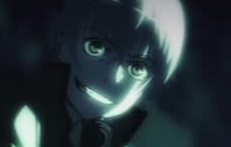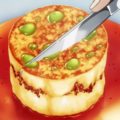A Wanderer has a Place in the World- Bungo Stray Dogs

“When did they make an anime of that? That looks good and sounds interesting” was my reaction when I saw posters advertising the premier of “Bungo Stray Dogs Bad Apple,” the movie version of an anime series for which two seasons had already been released. Now, the posters had portrayed the anime as one with high-quality artwork and with an interesting mix of characters, and it gave the impression that the series had been successful enough to warrant a movie to be produced. Color me intrigued.
First impressions were pretty positive, with bright, vibrant colors in the opening theme backed up by flashy animation and plenty of action that drew me in. However, all of these elements were put together in a balanced manner which resulted in a product that doesn’t feel overwhelming or feel as if one element were compensating for others or that the budget had all been spent to make the series look good. Then enter in the first couple of characters, including were-tiger Atsushi saving airheaded suicide enthusiast Dazai from trying to drown himself and I had entered the bizarre world where individuals with gifted abilities join a detective agency fighting crime against the Port Mafia. Now, the setting and sceneries themselves have an extraordinary amount of detail and rich color, and there is enough distinction in the character designs to make them stand out with enough quality so they don’t look too out of place from the backgrounds. The characters themselves are very distinctive personalitywise, but what is most appealing is that there is more than what meets the eye here. All the characters have a dominant personality, but behind the scenes there is much more that drives them, a side which only gets revealed once that dominant personality is peeled away and set aside. There is a lot of insecurity with Atsushi, a more serious side with Dazai, a more caring side with Kunikida, and so on and so forth. This also applies to the Port Mafia as well, especially with one of the first antagonists we see, Akutagawa. The first season is devoted to establishing and introducing the characters themselves coupled with Atsushi’s initiation into the Armed Detective Agency, so the character personalities themselves are rawer and the chemistry more clashing, which is great since it adds flavor and interest to the series, and seeing Atsushi’s character development into someone with more assertion and determination is refreshing and enjoyable. The battles themselves are well-choreographed and planned, with flashy animation and sharp motions portraying just how much vigor and assertion the characters themselves each have. However, what was a bit of a letdown was when the individuals activated their powers. While the battles themselves looked excellent, the powers of each of the characters were a bit generic and sometimes even made the battles anticlimactic, with the biggest issues being Dazai’s “No Longer Human” and Yosano’s “Thou Shalt not Die.” Though the plot for the first season is partly episodic, having there still be a storyline of Atsushi’s integration into the Armed Detective Agency is excellent, and the introduction of the character Kyoka in the second half of the first season plays well into developing Atsushi’s character and provides a somewhat graceful segue into the second season.

Now, the first season’s ending was only somewhat graceful, as while the final battle lets it end on a conclusive note, I felt a bit conflicted. The series was well constructed and conceived, with appealing characters and a great story. However, the powers of the characters themselves did blunt the appeal of the series itself, and the multitude of characters themselves did mean that there was only so much time devoted to each of them. However, speaking to the surprising number of cosplayers at several anime conventions I attended, the second season was slightly better than the first, but the fourth season (at that time having just started airing in April 2019) was excellent. Of course, with the number of cosplayers I had encountered, and with sufficient appeal plus a movie, surely there was something that I was missing, right?

The second season started out quite differently, and while it does continue on from the first season quite smoothly, it starts out instead with backstory. More specifically, Dazai’s backstory, and gives significantly more meaning to his character. His personality shift in this season is noticeable but does not feel like a break in his character so much as it does an enhancement to his character. It gives much more meaning to the subsequent plotline, which begins to move away from being episodic to a more rivalry-based system, with a much more complex character and relationship chart. These charts and the sheer number of characters added in make the second season much more difficult to follow, especially when the relationships from the first season still feel quite newly minted and haven’t had enough time to set and gel, but somehow, the story remains appealing and one doesn’t need encouragement to continue onwards. The two factions in the first season are now affected by governmental interference and a faction of gifted individuals known as “The Guild.” However, other aspects of the show’s first season carry over into the second season, such as the fantastic scenery and excellent music. The action sequences are much more exciting as not only are the new characters’ powers more interesting than in the first season, but the existing characters’ powers are put to better use in the battles as their owners can handle them better. The character chemistry is much stronger and more cohesive in this season versus last season, though the strong flavors and conflict each individual brings to the table results in an explosion of vivaciousness and excitement. There is less emphasis on battle choreography than strategy, and the dialogue can barely keep up with the story’s fast pace. It’s not say, shinkansen speed, but in order to get the story to fit into the number of episodes, it moves fast and allows for too much critical information to fall by the wayside and require a rewatch just to get.

The second season of “Bungo Stray Dogs” has to instead be treated as an extension of the first and it is better to treat the entire two seasons just as one show. But I was mightily impressed with what it brought to the table: great characters, great story, great artwork, great battles. There are flaws, of course, what with a too-fast plotline and somewhat bland implementation of the powers in the first season. However, by the end of the second season, because there were so many characters and each of them had their backstories and personalities built up a small amount, there were so many more opportunities for the story to continue on and it addresses many of the complaints I had about the first season. Of course, there is a movie and another season already out there, plus a desire to want to continue with the story. If that’s not the hallmark of a great show I don’t know what is. Well done, bring on the movie. To get a taste of “Bungo Stray Dogs” for yourself, try Crunchyroll or the boxsets.





